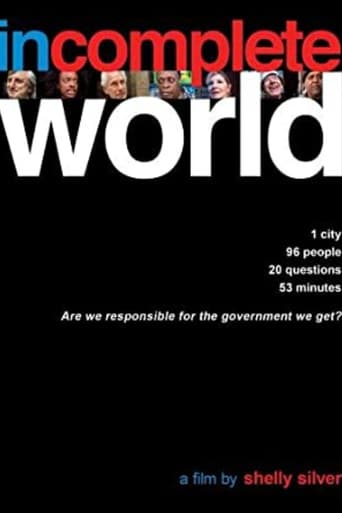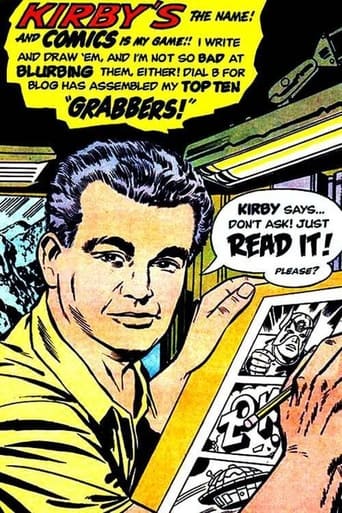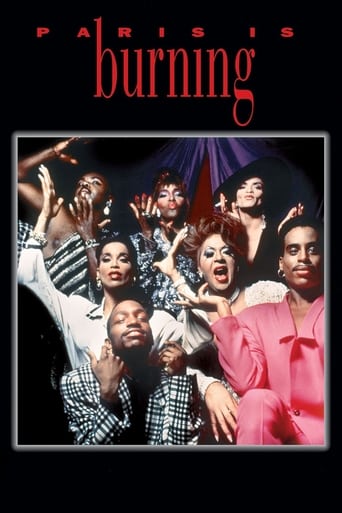


Gerhard Richter Painting
Gerhard Richter has spent over half a century experimenting with a tremendous range of techniques and ideas, addressing historical crises and mass media representation alongside explorations of chance procedures. This first glimpse inside his studio in decades is exactly that: a thrilling document of the 79-year-old's creative process, juxtaposed with rare archival footage and intimate conversations with his critics and collaborators.
-
- Cast:


Similar titles








Reviews
Surprisingly incoherent and boring
Simply A Masterpiece
Clever, believable, and super fun to watch. It totally has replay value.
The movie's neither hopeful in contrived ways, nor hopeless in different contrived ways. Somehow it manages to be wonderful
"Gerhard Richter - Painting" is a documentary from 2011, so this one has its 5th anniversary this year. It is a German production, which is also why the language is predominantly German except some English here and there. Gerhard Richter is a German painter who was in his late 70s when this was made and is now in his early 80s. He is considered among the painting elite right now and this also tells you that the great era of painters may be over as everybody has heard of Michelangelo, Picasso and many other famous painters, but in terms of the ones alive, hardly anybody is known I guess. But this should not discredit Richter's work. I think he has had a great career to this date and his talent has made him a fortune. So he probably deserves his own movie. The writer and director here is Corinna Belz and I recently got curious about her as I watched her very recent film about Peter Handke in a theater. But back to this one here, Belz actually worked on the topic of Gerhard Richter on several occasions ("Das Richter Fenster") also before this movie, which runs for slightly under 100 minutes. It focuses on Richter's work as an artist and the emphasis here is clearly more on his professional life than on his personal life. We see him on opening, on discussions with exhibitors or just find out about his general take on life and art as we see him (for example in the final shot) during his craft. The thing I liked most about the film is how very unpretentious the man is. He seems like a normal neighbor really and this is such a contrast to Handke for example. There was one scene when the filmmaker asks Richter to explain one particular quote or statement because it sounds really difficult and he basically responds by saying that it is too difficult to explain actually. A really likable man. But I still guess with the approach Belz gave the subject here, you need to have a solid interest at least in the subject before and with subject I mean the work of (modern) art. This is unfortunately not a movie that will get you interested in the subject if you haven't a previous interest already. And this makes it worth seeing for a not that huge group of people really, which is pretty disappointing and the reason why I give this film a thumbs-down. Not recommended to general audiences.
Many of the negative commentaries about this documentary assume that Richter wanted to be left alone and should be left alone; or alternatively, that Corinna Belz should have pried more intensely with "deep, probing" questions to Richter about the nature of his creativity, his technique, his background , etc. These objections show a certain lack of sensitivity and openness to what was actually offered in the documentary. In fact, at some point Richter complained that he did not behave as he normally would with the eye of the camera always around, and still the film got made! This was an act of incredible generosity and courage on Richter's part. Even while he remains circumspect, we do see him working. The whole voyeurism exercise could pose perhaps a risk to the evaluation of his work by posterity. It may also represent a teaching legacy for those who are able to learn from what they glimpse of his technique in the film. I can imagine that the director could have designed with the assistance of critics and scholars all kinds of challenging aesthetic questions, and risk a pedantic approach to the experience; but Ms. Belz chose a delicate touch in the end --indeed like the visit of a friend--and did not force the reactions of the artist. For those paying attention, there is a lot to learn from this film. However, beyond the recognition of Richter's generosity in letting us peep into his world, it is logical to believe that someone that looks so fit for his age, plans his exhibits in small scale, and works in such a clean architectural environment did keep the right to vet the final results in this film. Glimpses of his personal life are very few. His first two wives do not appear except in unlabeled portraits and you would not recognize them for who they are; his parents are mentioned briefly even though he did not see them again after his flight from East Germany; his young wife is an exquisite brief presence. In short, the film is probably a reflection of his disciplined persona.For those who care to see what was offered without the bitterness of not having accomplished this themselves, there is much to be praised in this film. My only complain concerns the English supertitles, which were not done with care. They can barely be read in half of the film. I hope this will be corrected at some point.
The only reason I gave this film 9 out of 10, was because I believe Corinna should have invested in a roller for her tripod. Would have made for less shaking in the videos of Richter while he is painting. As a documentary filmmaker and painter myself. I can fully understand and admire what Ms. Belz accomplished in this film. I do however, remembering seeing the film this past Friday, note that I wish the lower 3rd titles had been a bit bigger for those who wear glasses. I know it was OK for me, but i'm sure a number of people were always asking... "who is that?".I can truly admire this historical document on modern painting. As Richter is not a "post" anything. He is someone who is dedicated to making what he feels is the best work he can do. You will see that in the sections where Ms. Belz speaks with Richters assistants. What they say rings true with many many modernist painters who will have to sit with a work for months before they feel it is ready to be put out in the world.So glad this film is out in the world. I can't wait for the DVD. My only sadness about the DVD is that I don't have the equipment to watch it in the format I first viewed in. This film deserves a big screen.
* Contains spoilers *Arshile Gorky's wife reported, when he was still working in his New York studio, that she would see a canvas in one state, and, by the time that she awoke, it had been worked upon so much that it was largely unrecognizable. There are elements of this in what Gerhard Richter seeks to achieve in spite of the presence of those filming him at work, but that is the territory of this kind of work, and, really, it ought not to be too surprising (to which I shall return later).Rather than wondering, rather pointlessly, whether Gorky would have allowed director Corinna Belz in when he was working, I can only profess admiration for Richter that, despite the fact that it was putting him off, he did not close down the access. That said, whether he would have welcomed – or, if given the choice, approved of – the temporal juxtaposition of how what he was working on looked at different moments, I do not know.What I do know is that he loads the squeegee with paint, and then has to say that what he was about to do cannot be done then, because it will not succeed. Whatever Richter may 'really' be like, he gave the impression on camera of being a sensitive man, and he seemed unnerved that he had started preparing for something that was not possible, and which, one would like to think, he might not have done, if he had felt at ease. He did not, not when trying to work on his canvases.Indeed, following on from that, if we invest an artist and his or her work with worth, then we have to leave him or her free to decide when a work is finished, and what is effective and what is not. And yet I am imagining that the moment when he white-washes over a grey composition may have left some who watched the film wishing that he had left it untouched: I can understand that, but I take the different view – that he created it, and he must be satisfied with it, if it is to bear his name.His assistants, his wife, recognize the knife-edge on which the creative process is balanced at this stage, and say that, if they were to comment that they think that something is right as it stands, what they have said would be more likely to cause Richter to re-work it. Not out of perversity, I fully believe, but because, as the camera and crew do, the remark would interrupt and subvert the process.Unlike artists who have their studios, and would, throughout history, delegate tasks to assistants, Richter's was shown getting the paint ready, but the artist himself was even cleaning off his materials at the end of the session. He was, as he several times expressed in response to questioning (some of which was better and more artistically minded than other parts of it), clearly finding his way with the works, and we were told about how their current state had to stand up (as if to scrutiny, scrutiny of a most honest kind – and Richter believes in truth in painting) for several days: white-washing over was not something over which those in his entourage could regularly afford to be regretful.As I say, the creation is the artist's, and he or she is the one to find a way ahead. In the case, for example, of Joan Miró, he had the luxury of being able to re-work canvases decades later that were still in his possession, whereas the Tate refused, I think, Francis Bacon, access to some of his, because it did not want them – as it owned them – any different from how they were, and knew that that would be the result otherwise.One observation, amongst many intelligent things that Richter said about his work (and it was also fascinating to see him about the business not only of planning out exhibition spaces in 1:50 scale, but to hear him pleading with photographers at the opening of a show who required just one more pose that they had so many shots already), was that a painting makes an assertion that does not bear much company: in the context of having to hang several pieces on each wall, and plan it all out, that seemed just as much a challenge as in the studio, with canvases making differing assertions in different ways about how they should work.So the supremacy of each work's voice, its statement, and, I would say, for the painter to decide what it is to say and when it is saying it. Then, for Richter, what he said that he valued was people adopting the attitude of those attending a gallery in New York, who would more freely, more honestly, say that they liked this group of paintings, but that the grey compositions were terrible. The point that he was making is he does not feel the polite comment that something is 'interesting', to which he is usually exposed, is that kind of genuine response.As for me, I'm looking forward to spending time at the new exhibition at Tate Modern – and maybe to watching this film again there during the time that it is on.
